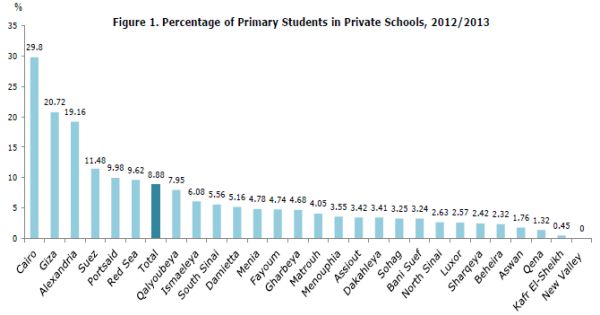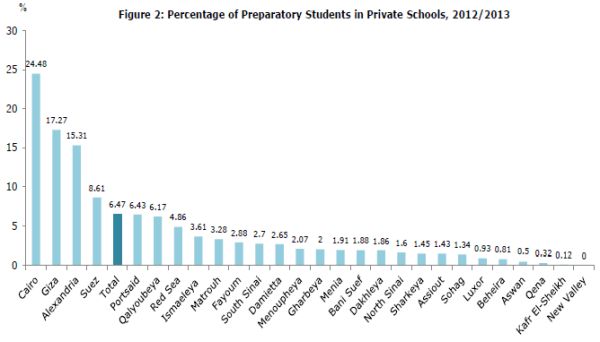INTRODUCTION
Education is the key to development of societies and the driver of its progress. Despite efforts by the state to implement reform-oriented educational policies, and the allocation of substantial resources to spending on education and developing government schools to accommodate the steady increase in classroom density, the government remains unable to provide an acceptable quality of education.
The education system in Egypt faces many problems, including high classroom density, multiple-shift schools, and weak facilities and technological aids. This has weakened students' ability to understand, discuss and research, rendering teaching to a mere memorization effort. Hence the necessity to shift education provision from being solely the responsibility of the state to expanding partnership with the private sector. This is dictated by reality and would reduce the burden on the public budget and address the education needs of the well-off segments of society.
Specifically, this study aims to highlight the licensing procedures for establishing private basic education schools that employ the Egyptian national system of education. The purpose is to determine the most important obstacles and suggest solutions that would encourage the private sector to utilize its potentials in funding and developing the educational system. This would be achieved through facilitating procedures of establishing private schools, and developing legislations that allow a fair rate of return on investment in this field.
Distribution of Private Schools
According to the Central Agency for Public Mobilization and Statistics (CAPMAS), private schools are concentrated mainly in major governorates such as Cairo, Giza and Alexandria, while they are almost minimal or non-existent in some governorates in Lower and Upper Egypt. Figures 1 and 2 below show the percentage of students registered in primary and preparatory private schools in each governorate in 2012/2013:1


Source: Central Agency for Public Mobilization and Statistics (CAPMAS).
Scope of the Study
This study addresses licensing procedures for establishing and operating private schools (Arabic and language schools) that employ the national education system. It covers basic education stages only (primary and preparatory stages) in Cairo and Giza.
The study relies on the following laws and regulations:
- Law no. 139/1981 on education and its amendments
- Ministerial decree no. 420/2014 on private education
Methodology
For the purposes of this study, we visited the Private Education Department at the Ministry of Education, and the General Authority for Educational Buildings. We also held several meetings with the staff in charge of licensing the establishment of private schools and with some owners of private schools in order to identify the licensing procedures for establishment and operation of private schools, and the major constraints encountered in this regard.
Study Plan
The study begins with a short review of the licensing procedures for establishing and operating private schools in Egypt. It then proceeds to discuss some of the problems and constraints encountered in each stage.
LICENSING PROCEDURES FOR ESTABLISHING AND OPERATING PRIVATE SCHOOLS IN EGYPT
Licensing procedures for establishing and operating private schools are comprised of three main stages, namely, obtaining a license to establish a school (preliminary approval from the mudereya (the Educational Administration) approval of the Educational Buildings Authority); obtaining a permit for building a school from the district authorities; and obtaining a license to operate a school after completion of the construction.
Obtaining a license to establish a school (preliminary approval from the mudereya (the Educational Administration) approval of the Educational Buildings Authority)
In general, licensing procedures begin with founding a company owning the private school, then assigning a legal representative of this company to undertake all licensing procedures for establishing and operating the school. The school's legal representative submits to the concerned mudereya (the Educational Administration) an application to establish a school, using a specific form. After fulfilling all document requirements as indicated in the form, the applicant obtains a preliminary approval to begin school establishment procedures. The next stage includes preparing the architectural drawings for the school and submitting them to the General Educational Buildings Authority for approval.
Obtaining approval from the Educational Buildings Authority on the architectural drawings of the School is the most time-consuming procedure and one of the most complicated; as it could take almost over two years. This is due to the following:
- difficulty involved in fulfilling document requirements for obtaining the plot of land on which the school will be built;
- difficulty of changing land allocation to educational purposes; and
- inadequate requirements for the selection of legal representatives;
Obtaining a permit for building a school from the district authorities
The applicant has to obtain a building permit from the concerned district authorities, which may reject the architectural drawings, although they were approved by the Educational Buildings Authority at an earlier stage, or because land allocation cannot be changed to educational purposes. This drives the applicant to build the school without a permit and therefore becomes subject to judiciary procedures that may be taken against him/her.
Obtaining a license to operate a school after the completion of construction
The mudereya Educational Administration forms a technical committee to inspect the school building and compares it against the drawings previously approved by the General Authority for Educational Buildings.
The school administration sets school fees on a discretionary basis during the first year of operation. The mudereya Educational Administration committee reviews school fees in light of the school's actual budget during its first year, taking into account a profit margin for the school owner.
Article 36 of Ministerial Decree No. 420/2014 stipulates the procedures for increasing school fees based on a decision by the Minister of Education specifying school fees brackets. The request to increase fees entails complicated procedures and requires the approval of several administrative authorities, starting from the mudereya Educational Administration all the way to the Minister of Education himself.
The government sets a specific percentage of increase in tuition fees with a view to protecting parents from exaggerated fees. In this respect, the interests of private school owners should also be taken into account, especially in light of increasing annual inflation rates. This will prevent private school owners from resorting to other means of fundraising from parents such as school uniforms, parties and donations, etc.
Finally, the state is well-advised to support and encourage the private sector to invest in the educational sector, which requires, inter alia, reforming/developing laws and regulations that allow a fair return on investment in the field of education, and hence attract investors to this vital area. Facilitating procedures for establishing private schools and eliminating obstacles encountered by private school owners are also of the essence.
To be sure, increased private sector participation in the provision of educational services in Egypt does not mean that the state will abandon its role in providing free education or increase the financial burden on the parents. Rather, it creates diversity in educational and teaching methods, and thereby eases the pressure on public schools. This will create a positive atmosphere of competition and eventually improve the quality of education provided.
REFERENCES
The amended Constitution of the Arab Republic of Egypt, Official Gazette, issue no. 3, January 18th, 2014.
Law no. 139/1981 on Education, official gazette, issue no 34, August 20, 1981, and the consecutive amendments thereof, the last of which is law no. 93/1912 amending some rules of Law no. 155/2007 amending Law no. 139/1981 on education.
Decision of the Minister of Education No. 420 for the year 2014, the Egyptian Waqeye', issue no. 222 (continued) on September 29, 2014, as amended by decree of the Minister of Education no. 299 for the year 2015.
Soundness standards and requirements for school sites and buildings, public primary and secondary schools located in cities and villages, as issued by the General Authority for Educational Buildings in 2013 (or the so-called book of terms and conditions).
Soundness standards and requirements for school sites and buildings, public primary and secondary schools located in new urban communities, as issued by the General Authority for Educational Buildings in 2011 (or the so-called book of terms and conditions).
A report on "Education for All 2015 National Review Report: Egypt" by the National Center for Pedagogic Research and Development, Ministry of Education, based on a call from the UNESCO-Egypt, accessible at http://unesdoc.unesco.org/images/0022/002299/229905e.pdf
CAPMAS, the Statistical Yearbook, 2014. Accessible at: http://www.capmas.gov.eg/Pages/StaticPages.aspx?page_id=5034
Footnote
1. CAPMAS, the Statistical Yearbook, 2014. Accessible at: http://www.capmas.gov.eg/Pages/StaticPages.aspx?page_id=5034
The content of this article is intended to provide a general guide to the subject matter. Specialist advice should be sought about your specific circumstances.

